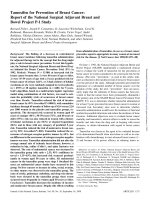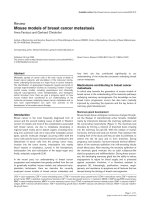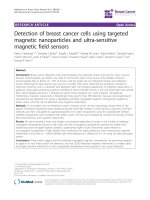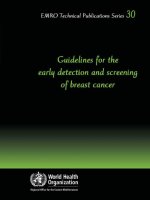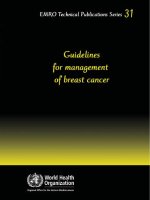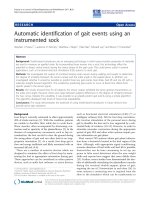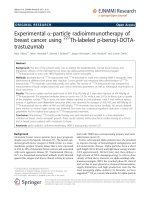Automated identification of breast cancer using higher order spectra
Bạn đang xem bản rút gọn của tài liệu. Xem và tải ngay bản đầy đủ của tài liệu tại đây (1.5 MB, 77 trang )
SIM UNIVERSITY
SCHOOL OF SCIENCE AND TECHNOLOGY
AUTOMATED IDENTIFICATION OF BREAST
CANCER USING HIGHER ORDER SPECTRA
STUDENT : YOGARAJ (Z0605929)
SUPERVISOR : DR RAJENDRA ACHARYA U
PROJECT CODE : BME499, JAN09/BME/20
A project report submitted to SIM University in partial fulfilment
of the requirements for the degree of
Bachelor (Hons) in Biomedical Engineering
Jan 2009
1
TABLE OF CONTENTS
Title Pages
ABSTRACT 4
ACKNOWLEDGEMENTS 5
LIST OF FIGURES 6
LIST OF TABLES 7
CHAPTER 1
INTRODUCTION 8
CHAPTER 2
DATA ACQUISITION 16
CHAPTER 3
PREPROCESSING OF IMAGE DATA 17
3.1 Histogram Equalization 17
CHAPTER 4
FEATURE EXTRACTION 18
4.1 Radon Transform 18
4.2 Higher Order Spectra 20
4.2.1 Higher Order Spectra Features 23
CHAPTER 5
CLASSIFIERS AND SOFTWARE USED 25
2
5.1 Support Vector Machine (SVM) 25
5.2 Gaussian Mixture Model (GMM) 28
5.3 MATLAB 30
CHAPTER 6
RESULTS 32
CHAPTER 7
DISCUSSION 36
CHAPTER 8
CONCLUSION 38
CHAPTER 9
CRITICAL REVIEW
9.1 Criteria and Targets 39
9.2 Project Plan 40
9.3 Strengths and Weaknesses 41
9.4 Priorities for Improvement 42
9.5 Reflections 43
REFERENCES 45
APPENDIX
Appendix A: Anova Results from website 50
Appendix B: Anova Results, in Excel format 51
Appendix C: Test Data Results, in Excel format 52
Appendix D: Example of HOS programming, in MATLAB format 53
Appendix E: MATLAB Codes 54
ABSTRACT
3
Breast cancer is the second leading cause of death in women. It occurs when cells in
the breast begin to grow out of control and invade nearby tissues or spread
throughout the body.
This project proposes of a comparative approach for classification of the three kinds
of mammograms, normal, benign and cancer. The features are extracted from the raw
images using the image processing techniques and fed to the two classifiers, the
support vector machine (SVM) and the Gaussian mixture model (GMM), for
comparison.
The aim of this study is to, develop a feasible interpretive software system which will
be able to detect and classify breast cancer patients by employing Higher Order
Spectra (HOS) and data mining techniques. The main approach of this project is to
employ non-linear features of the HOS to detect and classify breast cancer patients.
HOS is known to be efficient as it is more suitable for the detection of shapes. The
aim of using HOS is to automatically identify and classify the three kinds of
mammograms.
The project protocol uses 205 subjects, consisting of 80 normal, 75 benign and 50
cancer, breast conditions.
ACKNOWLEDGEMENTS
4
I would like to extend my heartfelt gratitude and appreciation to many people who
had made this project possible.
I would like to thank The Digital Database for Screening Mammography (DDSM) of
USA, for providing the source data in this mammographic image analysis.
I would like to thank my tutor, Dr. Rajendra, who had given me the opportunity to
undertake this project and also for his continuous support, guidance and
encouragement.
I would also like to express my appreciation to, Dr Lim Teik Cheng, Head of
Multimedia Technology and Design, for his talks on, “Introduction to the ENG499,
BME499, MTD499 and ICT499 Capstone Projects” and “Briefing on submission of
Thesis and Poster Presentation procedure”, and Dr Lim Boon Lum for his talk on,
“Introduction to MATLAB Applications for FYP Projects”. These talks guided me
through my journey.
The facilities at the Bioelectronics and Biomedical Engineering at UniSIM and Ngee
Ann Polytechnic were utilized for this work and I gratefully acknowledge them.
Special thanks to my family and friends, for letting me carry on my research in peace
while they prepared for Deepavali and other important family events.
I would also like to thank my colleagues from Republic Polytechnic (RP), for their
full support and understanding in covering my duties during my periods of leave.
LIST OF FIGURES Pages
5
Figure 1.1: Anatomy of a Breast 9
Figure 1.2: Anatomy of the Breast 9
Figure 1.3: Benign Breast Image 14
Figure 1.4: Tumour on Left Breast 14
Figure 1.5: Tumour on Right Breast 14
Figure 1.6: Classification Block Diagram 15
Figure 2.1: Normal Breast Image 16
Figure 2.2: Benign Breast Image 16
Figure 2.3: Cancer Breast Image 16
Figure 4.1 and 4.2: Schematic Diagram of Radon Transformation 19
Figure 4.3, 4.4 and 4.5: An example of a Radon Transformation 19
Figure 4.5: Bispectrum Diagram 23
Figure 5.1: An example of GUI 31
LIST OF TABLES Pages
6
Table 6.1: Classifier Input Features 32
Table 6.2: SVM Classifier Results 33
Table 6.3: GMM Classifier Results 33
Table 6.4: Accuracy of SVM and GMM classifiers 34
Table 9.1: Criteria/Targets and Achievements 39
CHAPTER 1: INTRODUCTION
7
The human breast is made up of both fatty tissues and glandular milk-producing
tissues. The ratio of fatty tissues to glandular tissues varies among individuals. In
addition, with the onset of menopause and decrease in estrogens’ levels, the relative
amount of fatty tissue increases as the glandular tissue diminishes [12].
The breasts sit on the chest muscles that cover the ribs. Each breast is made of 15 to
20 lobes. Lobes contain many smaller lobules. Lobules contain groups of tiny glands
that can produce milk. Milk flows from the lobules through thin tubes called ducts to
the nipple. The nipple is in the centre of a dark area of skin called the areola. Fat fills
the spaces between the lobules and ducts.
The base of the breast overlies the pectoralis major muscle between the second and
sixth ribs in the non-ptotic state. The gland is anchored to the pectoralis major fascia
by the suspensor ligaments. These ligaments run throughout the breast tissue from
the deep fascia beneath the breast and attach to the dermis of the skin. Since they are
not taut, they allow for the natural motion of the breast. These ligaments relax with
age and time, eventually resulting in breast ptosis. The lower pole of the breast is
fuller than the upper pole. The tail of Spence extends obliquely up into the medial
wall of the axilla.
The breast also overlies the uppermost portion of the rectus abdominis muscle. The
nipple lies above the inframammary crease and is usually level with the fourth rib
and just lateral to the mid-clavicular line.
8
Figure 1.1: Anatomy of a Breast
The breasts also contain lymph vessels. These vessels lead to small, round organs
called lymph nodes. Groups of lymph nodes are near the breast in the axilla
(underarm), above the collarbone, in the chest behind the breastbone, and in many
other parts of the body. The lymph nodes trap bacteria, cancer cells, or other harmful
substances [11].
Figure 1.2: Anatomy of the Breast
9
Breast cancer is a cancer that starts in the breast, usually in the inner lining of the
milk ducts or lobules. There are different types of breast cancer, with different stages,
aggressiveness, and genetic make-up.
While the majority of new breast cancers are diagnosed as a result of an abnormality
seen on a mammogram, a lump or change in consistency of the breast tissue can also
be a warning sign of the disease.
Research has yielded much information about the causes of breast cancers, and it is
now believed that genetic and/or hormonal factors are the primary risk factors for
breast cancer. Staging systems have been developed to allow doctors to characterize
the extent to which a particular cancer has spread and to make decisions concerning
treatment options. Breast cancer treatment depends upon many factors, including the
type of cancer and the extent to which it has spread.
Some types of breast cancers require the hormones estrogens’ and progesterone to
grow and have receptors for those hormones. Those types of cancers are treated with
drugs that interfere with those hormones and with drugs that shut off the production
of estrogens’ in the ovaries or elsewhere. This may damage the ovaries and end
fertility [11].
The most common types of breast cancer begin either in the breast's milk ducts
(ductal carcinoma) or in the milk-producing glands (lobular carcinoma). The point of
origin is determined by the appearance of the cancer cells under a microscope.
In situ (non-invasive) breast cancer refers to cancer in which the cells have remained
within their place of origin, which means they haven't spread to breast tissue around
the duct or lobule. The most common type of non-invasive breast cancer is ductal
carcinoma in situ (DCIS), which is confined to the lining of the milk ducts. The
abnormal cells haven't spread through the duct walls into surrounding breast tissue.
With appropriate treatment, DCIS has an excellent prognosis [12].
10
Invasive (infiltrating) breast cancers spread outside the membrane that lines a duct or
lobule, invading the surrounding tissues. The cancer cells can then travel to other
parts of your body, such as the lymph nodes.
Invasive ductal carcinoma (IDC) accounts for about 70 percent of all breast cancers.
The cancer cells form in the lining of the milk duct, then break through the ductal
wall and invade the nearby breast tissues. The cancer cells may remain localized,
staying near the site of origin or spread throughout the body, carried by the
bloodstream or lymphatic system.
Invasive lobular carcinoma (ILC), although less common than IDC, this type of
breast cancer invades in a similar way, starting in the milk-producing lobules and
then breaking into the surrounding breast tissues. ILC can also spread to more distant
parts of the body. With this type of cancer, typically, no distinct, firm lump is felt, but
rather a fullness or area of thickening occurs.
Breast cancer is the second leading cause of death in women. It occurs when cells in
the breast begin to grow out of control and invade nearby tissues or spread
throughout the body [11, 12].
The cause of the disease is not understood till now and there is almost no immediate
hope of prevention. Survival after treatment is improving but, the fact that, 66
percent of breast cancer victims die from it, is alarming. Early detection is still the
most effective way of dealing with this situation.
Because the breast is composed of identical tissues in males and females, breast
cancer can also occur in males. Incidences of breast cancer in men are approximately
100 times less common than in women, but men with breast cancer are considered to
have the same statistical survival rates as women.
11
The incidence of breast cancer is increasing worldwide and the disease remains a
significant public health problem. In the UK, all women between the ages of 50 and
70 are offered mammography, every three years, as part of a national breast
screening programme.
About 385,000 of the 1.2 million women diagnosed with breast cancer each year,
occur in Asia.
These issues, narrow down to the detection of breast cancer early, so that there is a
higher chance of successful treatment. The fact that the earlier the tumour is
detected, the better the prognosis, has led to the increase of methods used for
detection.
An ultrasound uses sound waves to build up a picture of the breast tissue. Ultrasound
can tell whether a lump is solid (made of cells) or is a fluid-filled cyst. It can also
often tell whether a solid lump is likely to be benign or malignant.
A needle (core) biopsy may be done. A doctor uses a needle to take a small piece of
tissue from the lump or abnormal area. Needle biopsies are often done using
ultrasound to guide the doctor to the lump. A fine needle aspiration (FNA) is a quick,
simple procedure which is done in the outpatient clinic. Using a fine needle and
syringe, the doctor takes a sample of cells from the breast lump and sends it to the
laboratory to see if any cancer cells are present.
12
Currently, the most common and reliable method is, mammography. Studies have
shown that, there is a decrease in both breast cancer and modality, in women who
regularly go for mammography, due to early detection and followed up treatment [4].
High-quality mammography is the most effective technology presently available for
breast cancer screening. Efforts to improve mammography focus on refining the
technology and improving how it is administered and x-ray films are interpreted.
A mammogram is a low-dose x-ray specially developed for taking images of the
breast tissue. Two or more mammograms, from different angles, are taken of each
breast. Mammograms are usually only used for women over the age of 35. In
younger women the breast tissue is denser; this makes it difficult to detect any
changes on the mammogram [36].
Using the mammogram, radiologists can detect the cancer 76 to 94 percent
accurately, compared to 57 to 70 percent detection rate, for a clinical breast
examination. The use of mammography results in a 25 to 30 percent decreased
mortality rate, in screened women compared after 5 to 7 years [25].
13
Figure 1.3: "Blobs" of white calcium can be seen in breasts, these are benign and do
not have the suspicious pleomorphic features as often seen.
Figure 1.4: There is a tumor in the left breast, the thickening and asymmetry between
sides can be noted.
Figure 1.5: There is a small speculated tumour in the middle of the right breast, left
side of figure.
14
The aim of this study is to develop a feasible interpretive software system which will
be able to detect and classify breast cancer patients by employing Higher Order
Spectra (HOS), and data mining techniques.
Two techniques were proposed to diagnose the abnormal mammogram based on
wavelet analysis for feature extraction and fuzzy-neural approaches for classification.
The system was able to classify normal from abnormal, mass for micro calcification
and abnormal severity, benign or malignant, effectively.
Image
Pre-Processing
Radon Transformation
Feature Extraction
SVM and GMM Classifiers
Normal Benign Cancer
Figure 1.6: Proposed block diagram for classification
In this work, I compare the performances of SVM and GMM classifiers for the three
kinds of mammogram images.
15
CHAPTER 2: DATA ACQUISITION
For the purpose of the present work, 205 mammogram images, consisting of 80
normal, 75 benign and 50 cancer breast conditions, have been used from the digital
database for screening mammography [14]. These images were stored in 24-bit TIFF
format with image size of 320x150 pixels.
The figures, 2.1, 2.2 and 2.3, below show the typical sample of normal, benign and
cancer mammogram images for different subjects respectively.
Figure 2.1 Figure 2.2 Figure 2.3
(Normal) (Benign) (Cancer)
16
CHAPTER 3: PREPROCESSING OF IMAGE DATA
Feature extraction is an important step and is widely used in classification processes.
This extraction is carried out after preprocessing the images. It is thus necessary to
improve the contrast of the image, which will aid us in getting good features during
the feature extraction process.
Pre-processing primarily consists of the following steps:
1) The image in RGB format is converted to a grayscale form.
2) The image is then subjected to histogram equalization.
3.1 Histogram Equalization
Histogram equalization improves the quality of the image considerably. This
technique reduces the extra brightness and darkness in the images. The distinct
features, of the image, are enhanced by increasing the contrast range. Histogram
equalization is the technique by which the dynamic range, of the histogram image, is
increased [10].
The intensity values of the pixels, in the input image, are assigned such that, the
output image contains a uniform distribution of intensities. Histogram equalization
results in uniform histogram and hence the contrast of the image is increased.
Histogram equalization is operated, on an image, in the following steps:
1) Histogram formation.
2) Calculation of new intensity values, for each intensity levels.
3) Replacing the previous intensity values with, the new intensity values.
17
CHAPTER 4: FEATURE EXTRACTION
The purpose of feature extraction is to reduce data by measuring certain properties,
which distinguish input patterns. An object is characterized by measurements, whose
values are very similar for objects in the same class and different for objects in a
different class [28].
The problem of invariant object recognition is a major factor, which is considered. I
consider invariance with respect to translational, rotational, and scale differences in
input images. Resolving the problem of invariance is critical, because of the large
number of training samples, which the classifier needs to be trained [5, 6].
4.1 Radon Transform
Radon transform and HOS are applied to generate RTS invariant [13]. This process
reduces the computational complexity of four dimensional spaces by computing the
original data from the 2-D domain to 1-D scalar functions by successive projections
via radon transformation.
The greyscale image is subjected to radon transformation, to convert the image into
1-D data, and then followed by HOS to extract the bispectral invariant features.
Radon transform is used to detect the features in the image. It transforms lines
through an image to points in the radon domain. Given a function:
),( yxA
The radon transform is given by:
( ) ( )
dsssAR
∫
∞
∞−
+−=
θθρθθρθρ
cossin,sincos,
Equation of the line can be expressed as:
θθρ
sin*cos* yx
+=
.
θ
is the small angle
and
ρ
is the distance to the origin of the coordinate system. The equation describes
the integral, along a line
s
through the image. Hence, radon transform converts 2D
signals into the 1D parallel beam projections, at various angles. In this work, I have
used
θ
=20
0
.
18
θπ
π
2
),(
θρ
R
θ
ρ
y
x
Figure 4.1 Figure 4.2
A schematic diagram of the radon transformation, from figure 4.1, image domain, to
figure 4.2, radon domain, is shown above.
Figure 4.3 Figure 4.4 Figure 4.5
An example of a radon transformation, from figure 4.3, benign raw image, to figure
4.4, benign gray scale image, and then to figure 4.5, benign radon image, is shown
above.
19
4.2 Higher Order Spectra
Ultrasound is one of the widely used medical imaging techniques, mainly because it
is versatile, relatively safe, not costly and also readily available. In medical imaging
applications, the major disadvantage of ultrasound, compared with other techniques
such as magnetic resonance imaging (MRI), is its low resolution and poor image
quality [35].
The scientific field of statistics provides many tools to handle random signals. In
signal processing, first and second order statistics have gained significant
importance. However, many signals, especially when it comes to nonlinearities,
cannot be examined properly by second order statistical methods. For this reason
HOS methods have been developed [31].
In the 1970s, HOS techniques were applied to real signal processing problems, and
since then HOS continued to expand into various fields, such as economics, speech,
seismic data processing, plasma physics, and optics.
Recently, HOS concept was used for epileptic EEG signals and cardiac signals to
identify their non-linear behaviour. HOS invariants have also been used for shape
recognition and to identify different kinds of eye diseases [33].
HOS is known to be efficient as it is more suitable for the detection of shapes. The
aim of using HOS is to automatically identify and classify the three kinds of
mammogram (normal, benign and cancer) [34].
This project proposes of a comparative approach for classification of three kinds of
mammogram: normal, benign and cancer. The features are extracted from the raw
20
images using the image processing techniques and fed to the two classifiers, the
SVM and GMM, for comparison.
The aim of this study is to, develop a feasible interpretive software system which will
be able to detect and classify breast cancer patients by employing HOS and data
mining techniques. The main approach of this project is to employ non-linear
features of the HOS to detect and classify breast cancer patients.
The linear spectral techniques contain only independent frequency components and it
does not indicate any phase information. Deviation of the signal from Gaussianity
can be quantified by higher order spectrum.
HOS is used for the analysis of a typical non linear dynamic behavior in any type of
system. It reveals both amplitude and phase information of a signal. It gives good
results when applied to weak or high noise signals. These statistics are known as
cumulants and their associated Fourier transforms (FT), are known as polyspectra.
The FT of the third order correlation of the signal is the bispectrum:
),(
21
ffB
of a
signal.
It is represented by:
)]().().([)(
21
*
212,1
ffXfXfXEffB +=
)( fX
is the Fourier transform of the signal
)(nTx
and
[.]E
stands for the
expectation process. These are categorized under HOS and additional information is
provided to the power spectrum. In practice, the expectation operation is replaced by
an estimate, which is an average over an ensemble of realizations of a random signal.
For deterministic signals, the above relationship holds without an expectation
operation, with the third order correlation being a time-average instead of an
ensemble average. For deterministic sampled signals,
)( fX
is the discrete-time FT
and, in practice, is computed at the discrete frequency samples using the fast Fourier
transform (FFT) algorithm. The frequency f may be normalized by the Nyquist
frequency to be between 0 and 1.
21
The bispectrum is blind to any kind of Gaussian process and is identically zero for a
Gaussian process [29, 30]. It has both magnitude and phase information of the signal.
The bispectrum may be normalized (by power spectra at component frequencies)
such that it has a value between 0 and 1 and indicates the degree of phase coupling
between frequency components [8, 26]. A normalized bispectrum will often be
devoid of false peaks. Peaks may appear due to the finite length of the process
involved even in the absence of phase coupling. The normalized bispectrum or
bicoherence is given by:
)()()(
)]*()()((
21
21
*
21
2121
),(
ffPfPfP
ffXfXfXE
co
ffB
+
+
=
, where
)( fP
is the
power spectrum.
22
4.2.1 Higher Order Spectra Features
The features used in my work, are based on the phases of the integrated bispectrum
[6, 7], and are briefly described below:
Assuming that there is no bispectral aliasing, the bispectrum of a real signal is
uniquely defined with the triangle 0≤f
2
≤f
1
≤f
1
+f
2
≤1. Features are obtained by
integrating along the straight lines, passing through the origin in bifrequency space
[37]. The region of computation and the line of integration are depicted in Figure 4.5
below.
f
2
f
1
0.5
0.5
1
Ω
12
aff
=
Figure 4.5: Non-redundant region of computation of the bispectrum for real signals.
The bispectral invariant
)(aP
is the phase of the integrated bispectrum along the
radial line with the slope =
a
. It is defined by:
)arctan()(
)(
)(
aI
aI
r
i
aP =
.
∫
+
+
=
=
+=
a
f
ir
dfaffB
ajIaIaI
1
1
1
0
111
),(
)()()(
for 0<a≤1, and j =
1−
.
The variables
r
I
and
i
I
refer to the real and imaginary part of the integrated
bispectrum respectively.
Features are calculated within the Ω region. These bispectral invariants
)(aP
contain
information about the shape of the waveform within the window and are invariant to
23
shift and amplification and robust to time-scale changes. They are sensitive to
changes in the left-right asymmetry of the waveform.
For windowed segments of a white Gaussian random process, these features tend to
be distributed symmetrically and uniformly about zero in the interval
],[
ππ
+−
. For the
chaotic process exhibiting a colored spectrum with third order time-correlations or
phase coupling between
Fourier components, the mean value and the distribution of the invariant feature, can
be used to identify the process. By changing the value of the slope
a
, different sets of
)(aP
can be obtained as input to the classifier.
In this work, I extracted 19 bispectrum invariants for each radon-transformed
mammogram image. Then the clinically significant parameters, among these, were
chosen as a candidate for classifier training. I chose
a
= 1/19, 10/19, 18/19 and 19/19
because P(1/19), P(10/19), P(18/19) and P(19/19) were clinically significant values,
(p<0.005).
CHAPTER 5: CLASSIFIERS AND SOFTWARE USED
24
In this work, I used two classifiers. These two classifiers, the support vector machine
(SVM) and the Gaussian mixture model (GMM), are explained below. I compared
the performances of SVM and GMM classifiers for the three kinds of mammogram
images.
5.1 Support Vector Machine (SVM)
In recent years, SVM classifiers have demonstrated excellent performance in a
variety of pattern recognition problems.
A SVM searches for a separating hyper plane, which separates positive and negatives
examples from each other with maximum margin, which means, the distance
between the decision surface and the closest example is maximised. Essentially, this
involves orienting the separating hyper plane, to be perpendicular to the shortest line,
separating the convex hulls of the training data for each class, and locating it midway
along this line.
The separating hyper plane is defined as:
0.
=+
bwx
,
w
is its normal.
For linearly separable data, {
i
x
,
i
y
},
i
x
d
N
ℜ∈
,
i
y
= {-1, 1}.
The value,
i
= 1, 2, 3, …,
N
.
The optimum boundary chosen with maximal margin criterion is found by
minimizing the objective function
2
wE
=
, subject to
,1)(
≥+⋅
ii
ybwx
for all
values of
i
.
The solution for the optimum boundary
0
w
is a linear combination of a subset of the
training data, s
∈
{1 … N}: the support vectors. These support vectors define the
margin edges and satisfy the equality
.1)(
0
=+⋅
ss
ybwx
25
